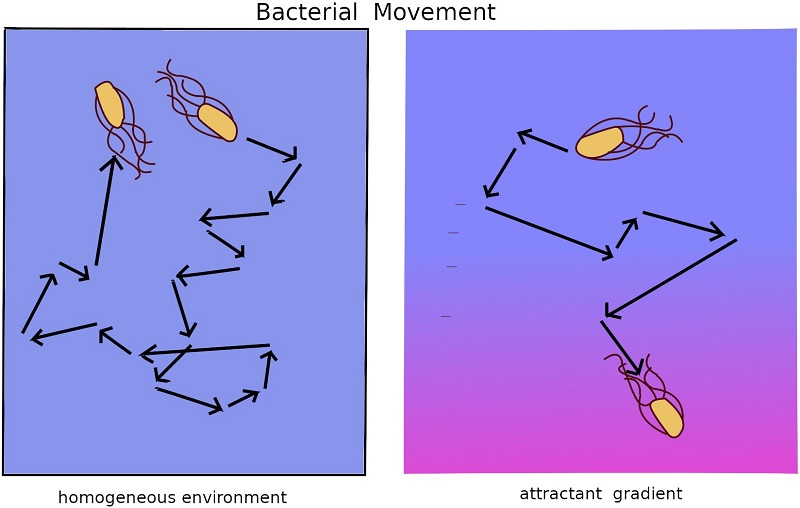Probing into the manner in which gut bacteria respond to sudden change in surrounding environment, scientists have found that extreme values of response is reached quickest at optimum size of changes and spotted intriguing ‘temporary adaptation’ for a brief moment long before the E.coli cells attain matching actual adaptation.
The study calculated how the cells change sharply to reach their maximal or minimal value conditions before they gradually relax to adapted levels in the long run. It can help understand how bacteria residing in the gut cope with changes in the chemical environment of the stomach during infections and find ways of treating them.
Certain organisms show the ability to navigate in a chemical environment, a phenomenon called chemotaxis. Bacterial cells like E.coli often use this motion to find food or to get away from poisonous chemicals in their environment.
Rod-shaped E.coli cells with 10 to 12 flagella move through a run-and-tumble motion. While runs take the cell from one place to another, a tumble gives the cell an opportunity to change its direction. When an E.coli cell finds itself in an environment where some regions have more food and some regions have less food, the cell modulates its run-and-tumble motion to migrate toward the region with more food.
To understand how the cell manages to regulate its runs, one has to look into the reaction network inside the cell body. One of the most important components of this network is chemo-receptors, which are trans-membrane proteins, part of them sticking out of the cell and part of them inside the cell. These receptor proteins can be in two different conformations or states, active and inactive. When a nutrient or attractant molecule that is present in the environment, binds to the external part of a receptor, the receptor changes its conformation and becomes inactive. In this state, flagellar motors show counter-clockwise (CCW) rotation and the cell swims smoothly. On the other hand, when the receptor is not bound to an attractant molecule, it remains in the active conformation. When a large number of receptors are active, the flagellar motors rotate in the Clockwise (CW) direction, and the cell tumbles.
Other than regulating the run-tumble motion according to the chemical environment, the reaction network inside the cell has another important task—to control the fluctuations in receptor activity. If for some reason, the receptor activity gets too high or too low, its value is restored to the average level via a mechanism of negative feedback. This makes sure that the cell is able to adapt to its environment.
If the attractant level in the environment is raised, receptor activity will initially decrease leading to very long runs, but after some time, due to the negative feedback present in the network, the activity will go back to its earlier value, such that the usual run-tumble motion of the cell can resume.
In many experiments the adaptation dynamics of an E.coli cell has been studied by measuring the time-variation of receptor activity and CW bias of the flagellar motors after the attractant level in the cell environment is changed suddenly (also known as step stimulus). But very little is known about their early time rapid variation as the rapidity in which the cell is thrown out of the adapted state makes it challenging to study this state.

FIG. 2. Migration of an E.coli cell towards higher attractant levels
In a paper published in the Journal of Statistical Mechanics: Theory and Experiment, scientists from S. N. Bose National Centre for Basic Sciences (SNCBS), an autonomous institute of the Department of Science and Technology, found that at the extreme point, the cell follows certain conditions which are expected to hold only in the adapted state. This ‘temporary adaptation’ for a brief moment long before it attains actual adaptation surprised the scientists since the cell is farthest away from any kind of adapted state at this point. Using mathematical analysis, they spotted striking similarities with an actual adapted state.

FIG. 1. Run and tumble motion of an E.coli cell
The researchers also found that the time taken for the activity to reach to extreme conditions depends on the amount of change in attractant (chemical that the E.coli cell gets attracted to) level in the environment (step size of the stimulus) and that there is an optimum size of the change at which the extreme values of response is reached quickest.
If the step size is too small, the cell takes a long time to reach the extreme values point, since for a very small step stimulus, the variation of activity or CW bias is also slow with time. On the other hand, for a large step, these quantities vary rapidly but their recovery takes a long time to start, which pushes the extreme values point towards large times. In between these two limits, lies the optimum step size, when the cell reaches the extreme values point in the shortest possible time.
Since E. coli cells live in our gut and play an extremely important role in digestion and also protect our body from other harmful microbes as well as produce vitamin K and vitamin B12 which are beneficial for us, it is important to understand how E. coli behaves in different types of environment.






























